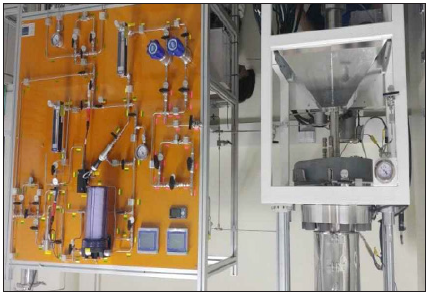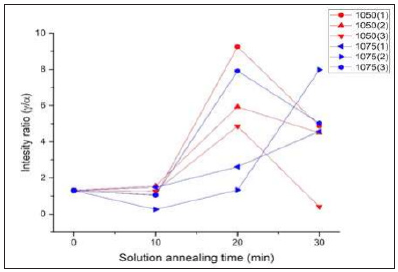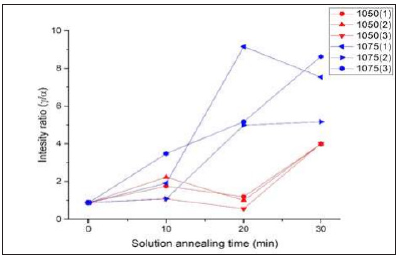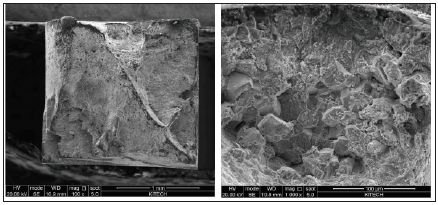- Submissions

Full Text
Novel Research in Sciences
Stress Corrosion Cracking Behaviour of Cold Worked AISI316L Stainless Steel in Chloride Environment
Yong-Soo Kim1 and Sung Joon Pak2*
1Dept. of Nuclear Engineering, Korea
2KITECH, Korea
*Corresponding author: Sung Joon Pak,KITECH, Korea
Submission: June 26, 2020;Published: August 19, 2020
.jpg)
Volume4 Issue3July, 2020
Abstract
The behaviour of solution annealing and stress corrosion cracking in cold worked AISI316L austenitic stainless steel have been studied using XRD and slow strain rate test (SSRT) technique. Based on the good compatibility to high temperature water environment, AISI316L austenitic stainless steel is widely used for internal structural materials of light water reactors. However, recently, Stress Corrosion Cracking (SCC) was noticed in the stainless steels for the applications in some commercial PWR plants. In this paper, the behaviour of the SCC and Inter Granular Cracking (IGC) are discussed on the basis of solution annealing and chloride environment. The martensitic contents of cold worked AISI316L stainless steel decreased as solution annealing time increased with higher temperature. The mode of SCC was deeply related to the chloride environment. Therefore, it is considered that chloride environment plays an important role in SCC of cold worked AISI316L.
Keywords: Chloride;Solution annealing;Stress corrosion cracking; AISI316L;Austenitic stainless steels; SSRT
Introduction
Intergranular attack in austenitic stainless steels has been of great interests and investigated for about one century [1]. Specifically, intergranular corrosion and sensitization have been focused in relation to chromium depletion at the grain boundaries [2-8]. Austenitic stainless steels have been commonly used for internal structural materials of light water reactors and heavy water reactors, due to its good compatibility to high temperature water environment. However, in early 1970s, intergranular cracking (IGC) was observed in the 25%Cr-20%Ni austenitic stainless steel of the parts of fuel assembly for steam generating heavy water reactor [9] and the Cr depletion and Ni, Si enrichment were detected near the grain boundaries of this material. The material flow during plastic deformation process considerably affects the product quality - its structure and properties, the process efficiency and the deformation force amplitude. The changes of basic properties (resistance and plasticity) of the deformed material present importance to ensure the final mechanical characteristics of the parts for an appropriate behaviour in working condition [10,11]. The increase of α’ (110) martensitic structure by martensitic transformation induced by plastic deformation causes a change in physical properties of austenitic stainless steels. The martensitic transformation is expected to change by stress states. Even though stainless steels are known having a good resistance to general corrosion because they form a thin chromium rich passive surface film, they are susceptible to localized corrosion attack such as pitting, intergranular corrosion, and stress corrosion cracking [12-17]. We study the effects of solution annealing and stress corrosion cracking (SCC) on α’ martensitic phase of cold worked AISI316L. The SCC of AISI316L can be progress as IGC by the chloride environment and dissolved oxygen (DO) in SSRT test. The advantages of using chloride environment SSRT indicate the new contributions about SCC behaviour since there are many papers related to SCC of AISI316L is expected to progress by IGC.
Experimental Procedure
The material used in our study was a AISI316L austenitic stainless steel with its chemical composition shown in Table 1. AISI316L samples were cold rolled as 10% and 20%. Residual martensitic contents were detected using XRD after solution annealing. The dimensions of the samples for the corrosion test was 40×15×2 mm, and the gauge section of the SSRT specimens was 2×2 mm with a gauge length of 10 mm. The corrosion and SSRT tests were conducted in an autoclave connected to a water chemistry control loop. Figure 1 shows the photo of the test system, which can operate up to 20MPa and 360℃. The testing conditions for the corrosion and SSRT tests are listed in Table 2. The oxygen content was controlled by bubbling high-purity argon into the primary water with 2ppm Li and 1,200ppm Boron. Scanning electron microscope (SEM) techniques were used to characterize the fractured microstructure in the corrosion and SSRT.
Table 1: Chemical composition of the AISI316L austenitic stainless steel (wt. %).

Table 2: Test conditions for the corrosion and SSRT tests.

Figure 1: Photo of the corrosion and SSRT test system.

Results and Discussion
We evaluate solution annealing of cold rolled specimens. Figure 2 shows XRD properties measurement in relationship with intensity ratio (ɤ-austenite/á-martensite) for STS 316L specimens for 10% cold worked specimens. It is revealed that the martensitic phase properties depends on solution annealing time, possibly due to microstructure transfer processes at the grain boundaries. As shown in Figure 3, the similarity of different specimens also indicates that martensitic phase depends on solution annealing time. Fracture morphology after test in primary water (360℃, DO 5ppm, DCl4ppm) is shown in Figure 4. This reveals a significant stress corrosion cracking. Highly magnified view offered an evidence of intense corrosion along the grain boundaries of this specimen. Consequently, the attack to the grain boundaries of this specimen is apparently made into the deeper region, as it is clearly seen at low magnification. The results show that the DCl increases the intergranular corrosion of the specimens. The tests confirm the other results, showing the susceptibility to intergranular corrosion [3,17].
Figure 2: XRD properties measurement in relationship with intensity ratio (ɤ-austenite / á-martensite) for STS 316L specimens for 10% cold worked specimens.

Figure 3: XRD properties measurementinrelationship with intensity ratio (ɤ-austenite /á-martensite) for STS316L specimens for 20% coldworked specimens.

Figure 4: Fracture morphology after test in primary water (360℃, DO 5ppm, DCl4ppm).

Conclusion
Based on the good compatibility to high temperature water environment, AISI316L austenitic stainless steel is widely used for internal structural materials of light water reactors. However, recently, intergranular cracking was detected in the stainless steels for the applications in some commercial PWR plants. The susceptibility to intergranular corrosion of the cold worked AISI316L stainless steel was highly affected by martensite and cold working. The corrosion characteristics of the test specimens may be attributed to the transfer of microstructures (mainly martensitic structure). Consequently, the corrosion resistance of AISI316L can be improved with decreasing the martensitic content and DCL increases the SCC (IGC) in AISI316L stainless steel.
References
- Padilha A, Plaut R, Rios P (2007) Steel Heat Treatment Handbook, 2nd edn, CRC Press, FL, USA, p. 695.
- Zingales A, Quartarone G, Moretti G (1985) Corrosion 41(5): 136-141.
- Muraleedharan J, Gnanamoorthy B, Rodriguez P (1996) Corrosion 52(2): 790-800.
- Chattoraj I, Bhattamishra A, Jana S, Das S, Chakraborty S, et al. (1996) Corr Sci 38, pp. 957-969.
- Shankar P, Shaikh H, Sivakumar S, Venugopal S, Sundararaman D, et al. (1999) J Nucl Mater, 264, pp. 29-34.
- Sahlaoui H, Makhlouf K, Sidhom H, Philibert J (2004) Mater Sci Eng A 372, pp. 98–108.
- Stonawska Z, Svoboda M, Sozanska M, Kristková M, Sojka J (2006) J Microsc 224, pp. 62–64.
- Terada M, Saiki M, Costa I, Padilha A (2006) J Nucl Mater 358, pp. 40–46.
- Scott PM, Foot W, Goldsmith LA, Dumbill S, Williams TM, et al. (1987) NEA/UNIPEDE Specialists Mtg. on Life-Limiting & Regulatory Aspects of Core Internals and Pressure Vessels, Stockholm.
- Sanga M, Yukawa N, Ishikawa T (1997) International Symposium on Designing, Toyohashi, Japan.
- Gabrielson P, Schedin E, Ekstrand G (1999) Advanced Technology of Plasticity II, pp. 1383-1388
- NN, Contract 248/1999, Research on corrosion behaviour of heat exchanger plates from Apaterm SA, GALATI
- Chandra K, Kain V, Ganesh P (2008) J of Mater Eng and Performance 17, pp.115
- Solomon N, Solomon I, (2010) U.P.B. Sci Bull Series B, 72(4), p.197
- Kim K, Ju H, Moon Y, Hong J, Pak S (2016) Metall Trans 47, pp. 4979-4982
- Kim K, Lim S, Pak S (2015) Corrosion Science and Technology 14, pp. 93-98
- Solomon N, Solomon I (2017) Engineering Failure Analysis 79, pp. 865-875
© 2020 Sung Joon Pak. This is an open access article distributed under the terms of the Creative Commons Attribution License , which permits unrestricted use, distribution, and build upon your work non-commercially.
 a Creative Commons Attribution 4.0 International License. Based on a work at www.crimsonpublishers.com.
Best viewed in
a Creative Commons Attribution 4.0 International License. Based on a work at www.crimsonpublishers.com.
Best viewed in 







.jpg)






























 Editorial Board Registrations
Editorial Board Registrations Submit your Article
Submit your Article Refer a Friend
Refer a Friend Advertise With Us
Advertise With Us
.jpg)






.jpg)














.bmp)
.jpg)
.png)
.jpg)










.jpg)






.png)

.png)



.png)






